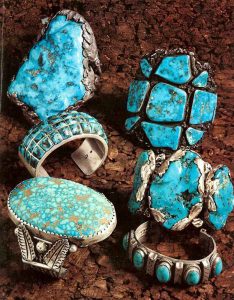




Art historians poetically refer to turquoise in silver as the quintessence of Kazakh jewelry art, which emphasizes its importance in the mythopoetic image of the world of ancient nomads. The color of turquoise – usually bluish – gives it the status of a celestial stone or a representative of heaven. The most famous Kazakh archeological findings of inlaid turquoise in gold show the treasure of the Kargaly hoard (the diadem and other gold objects), dating back to the 3rd century BC – 2nd century AD.
“The word “turquoise” is derived from the Persian “firyuza” (piryzen), which means “victorious, prosperous, bringing good luck” (in a Kazakh transcription this stone was called “pereze”). This explains its wide use in traditional jewelry art.
Turquoise was also actively used in medicine by many peoples of Central Asia


